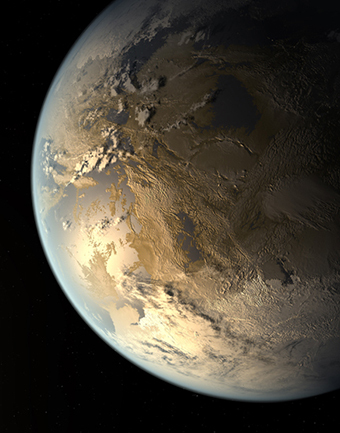Overview
Most of the exoplanets discovered so far are in a relatively small region of our galaxy, the Milky Way. We know from NASA’s Kepler Space Telescope that there are more planets than stars in the galaxy.
By measuring exoplanets’ sizes (diameters) and masses (weights), we can see compositions ranging from very rocky (like Earth and Venus) to very gas-rich (like Jupiter and Saturn). Exoplanets are made up of elements similar to those of the planets in our solar system, but their mixes of those elements may differ. Some planets may be dominated by water or ice, while others are dominated by iron or carbon. We’ve identified lava worlds covered in molten seas, puffy planets the density of Styrofoam and dense cores of planets still orbiting their stars.
The first exoplanets were discovered in the 1990s and since then we’ve identified thousands using a variety of detection methods. It’s pretty rare for astronomers to see an exoplanet through their telescopes the way you might see Saturn through a telescope from Earth. That’s called direct imaging, and only a handful of exoplanets have been found this way (and these tend to be young gas giant planets orbiting very far from their stars).
Now we live in a universe of exoplanets. The count of confirmed planets is in the thousands and rising. That’s from only a small sampling of the galaxy as a whole. The count could rise to the tens of thousands within a decade, as we increase the number, and observing power, of robotic telescopes lofted into space.
Most exoplanets are found through indirect methods: measuring the dimming of a star that happens to have a planet pass in front of it, called the transit method, or monitoring the spectrum of a star for the tell-tale signs of a planet pulling on its star and causing its light to subtly Doppler shift. Space telescopes have found thousands of planets by observing “transits,” the slight dimming of light from a star when its tiny planet passes between it and our telescopes. Other detection methods include gravitational lensing, the so-called “wobble method.”
But when multiple methods are used together, we can learn the vital statistics of whole planetary systems – without ever directly imaging the planets themselves. The best example so far is the TRAPPIST-1 system about 40 light-years away, where seven roughly Earth-sized planets orbit a small, red star.
The TRAPPIST-1 planets have been examined with ground and space telescopes. The space-based studies revealed not only their diameters, but the subtle gravitational influence these seven closely packed planets have upon each other; from this, scientists determined each planet’s mass.
So now we know their masses and their diameters. We also know how much of the energy radiated by their star strikes these planets’ surfaces, allowing scientists to estimate their temperatures. We can even make reasonable estimates of the light level, and guess at the color of the sky, if you were standing on one of them. And while much remains unknown about these seven worlds, including whether they possess atmospheres or oceans, ice sheets or glaciers, it’s become the best-known solar system apart from our own.
-
Planet TypesExoplanets come in a wide variety of sizes, from gas giants larger than Jupiter to small, rocky planets about as big around as Earth or Mars. They can be hot enough to boil metal or locked in deep freeze. They can orbit their stars so tightly that a “year” lasts only a few days; they can orbit two suns at once. Some exoplanets are sunless rogues, wandering through the galaxy in permanent darkness.
Next: Exoplanets - In Depth





